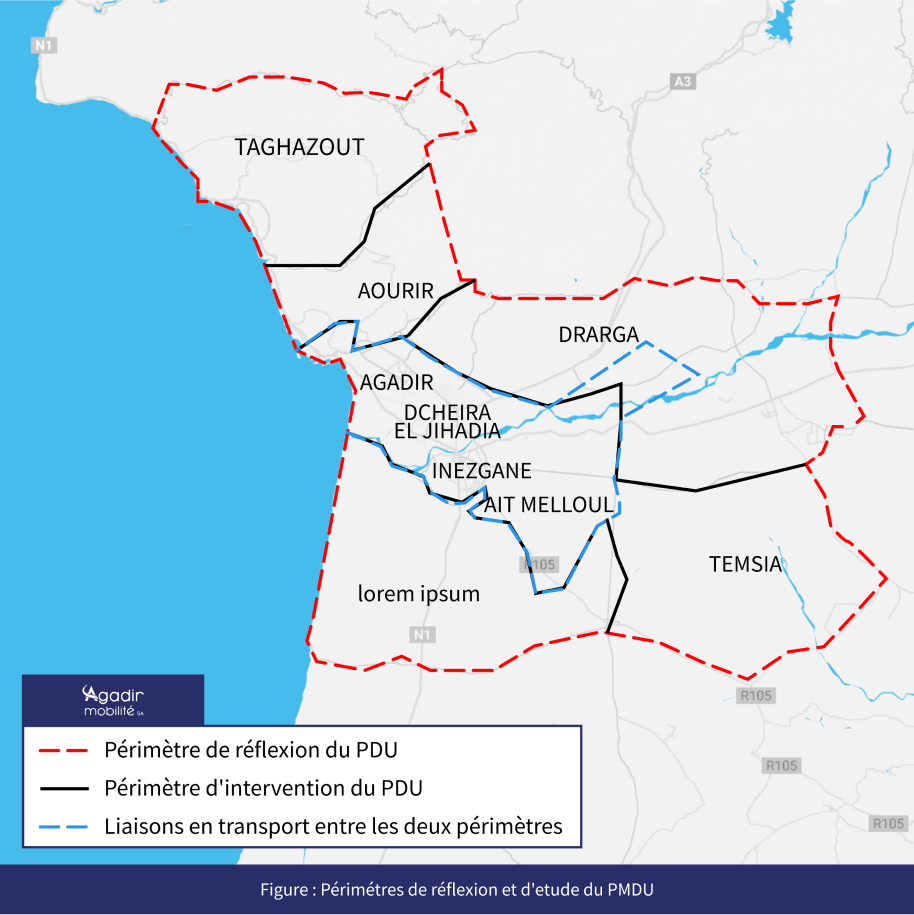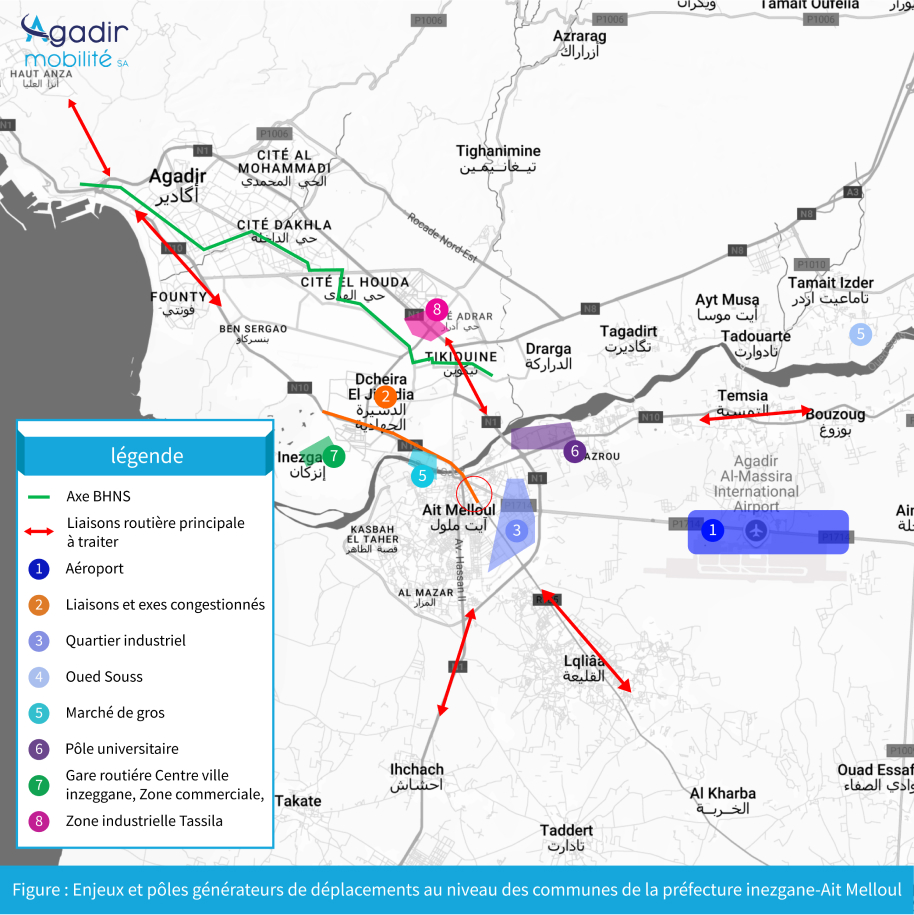Sustainable development is now considered the primary goal of advanced societies, aiming to correct accumulated socio-environmental imbalances and safeguard their future. In this context, Morocco has initiated a process to strengthen its political, institutional, and legal framework for environmental protection. This approach aligns with the United Nations Sustainable Development Goals (SDGs) and Morocco’s international commitments, particularly the Nationally Determined Contribution (NDC), which aims to reduce greenhouse gas emissions by 45.5% by 2030.
To implement this sustainable approach, the Kingdom has established a legal and institutional framework, including the adoption of the National Charter for Sustainable Development (CNDD) in 2014, integrated into Framework Law 99-12, based on the axes of the National Sustainable Development Strategy (SNDD) launched in 2013.
In this framework, the Grouping of Territorial Communities (GCT), through the SDL Agadir Mobilité, has recently launched its Sustainable Urban Mobility Plan (PMUD). This plan aims to develop a participatory approach that integrates gender, environmental, and sustainable development dimensions to address current needs while ensuring a more balanced and sustainable future.
What is a Sustainable Urban Mobility Plan (PMUD)?
The General Directorate of Territorial Communities states in its methodological guide that “A PMUD addresses the various urban mobility challenges, primarily ensuring that the territorial space meets the population’s accessibility needs while contributing to climate mitigation, adaptation objectives, and energy efficiency.”
Thus, it represents a new planning concept capable of tackling mobility challenges in urban areas within a sustainable and comprehensive approach. Unlike traditional urban transport planning approaches, this new concept emphasizes citizen participation, stakeholder engagement, the coordination of sectoral policies (transport, energy, environment, economic development, social policy, health, safety, etc.), and a long-term, sustainability-focused vision.
PMUDs promote a forward-thinking approach, incorporating societal benefits to internalize costs while emphasizing the importance of evaluation.
Key Concepts
• Urban Planning
Urban planning in Morocco aims to provide a structured framework for territorial development and organization, supporting a transition toward sustainability. The challenge lies in analyzing cities at multiple scales and integrating them into their broader metropolitan regions to create a harmonious urban environment, requiring comprehensive pre-planning.
Beyond spatial considerations, a sustainable city should be viewed as a system where different components interact. Therefore, it is crucial to move beyond sectoral approaches and instead prioritize synergies, fostering integrated planning and management. To achieve a sustainable city, Morocco must focus on aspects such as urban density, functional and social diversity, and urban accessibility.
• Urban Mobility
Mobility and transport in urban areas are essential for sustainable urban development. Urban mobility planning in Morocco, aimed at creating sustainable cities, represents a major challenge for stakeholders. This planning seeks both to enhance environmental sustainability and to reduce air pollution and greenhouse gas emissions, in line with the National Sustainable Development Strategy (SNDD) and Sustainable Development Goals (SDGs).
In this context, Sustainable Urban Mobility Plans (PMUDs), which have succeeded Urban Transport Plans (PDU), are crucial for achieving these global objectives. They provide a forward-looking vision for a more inclusive mobility system in social, economic, and environmental terms.
A Special Focus on Urban Planning and Mobility in Greater Agadir
Interest in this issue in Agadir is not new. It is the result of more than a decade of reflection and strategic studies aimed at improving mobility and transport conditions for Agadir’s residents.
The diagram below outlines the key milestones achieved so far:

During the same period, Greater Agadir was also covered by other urban and territorial planning documents. These must be taken into account in this mobility planning study to ensure better coordination with the area’s urban and economic development:
Regional Spatial Planning Scheme (SRAT)
This document aims to set the medium- and long-term guidelines for sustainable development in the region and define its overall vision through key objectives. These objectives concern the development of urban, peri-urban, and rural areas, their revitalization, the rehabilitation of degraded areas, and the protection and enhancement of the environment.
Urban Development Master Plan (SDAU)
This document outlines how urban development will be organized over a 25-year period through major planning and development actions within the study area:
- Balancing new economic, urban, social, and environmental challenges
- Positioning the territory in a sustainable and harmonious development framework while preserving its environmental assets (farmland, forests, natural habitats, water resources, sites of high biological and ecological value, historical and heritage sites, the coastline, etc.)
- Defining new urbanization zones
Urban Development Master Plan (SDAU) — Additional Clarification
It provides a long-term vision for the region, broken down into a regional strategy built on strengthened and renewed development drivers.
It places strong emphasis on implementation by planning and defining a concrete system for on-the-ground execution (communication platform, partnership policies, a regional execution agency, and local governance).
It also initiates the execution process.
Land Use Plans (PA)
These operational documents—many of which have already been approved or are in the process of approval—serve as the legal instrument that translates the guidelines of the Urban Development Master Plan into binding regulations for both the administration and third parties.
Need to Rethink Mobility Planning in Greater Agadir
Currently, with the structural changes taking place in Greater Agadir, there is a clear need to launch strategic and operational mobility planning studies to support its development. It is in this context that the GCT (Grouping of Territorial Communities) of Greater Agadir, through its executive arm SDL Agadir Mobilité, has initiated a study to develop the Sustainable Urban Mobility Plan (PMUD) and the Traffic and Parking Plans (PDCS) for Greater Agadir. These plans aim to account for new mobility conditions and build upon (and adapt to) major contextual and structural changes in the region.
Greater Agadir’s Mobility Challenges
With a population exceeding 1 million inhabitants and diverse economic activities—particularly tourism (it is Morocco’s second most popular destination after Marrakech), fishing, and the agro-food industry—Greater Agadir is striving to significantly improve the quality of both passenger and freight transport within its territory.
This strong commitment, which began over a decade ago and is now bearing fruit, seeks to set international standards and objectives for mobility management while considering the territory’s specific challenges and achievements.
Accordingly, the PMUD must follow this approach, especially through a bottom-up process that involves Greater Agadir stakeholders and requires a detailed understanding of its unique characteristics.
Greater Agadir’s main mobility challenges include:
- High tourist traffic, especially in the summer, complicating peak and super-peak traffic management and the provision of reliable transport services.
- Development of large logistics and industrial zones in the region, increasing the impact of heavy vehicles in terms of parking, traffic, and nuisances.
- Improved but still insufficient public transport supply: service to outlying centers remains limited, and the mass transit system (TCSP) currently has only one BHNS line not yet in operation.
- Complex connections between the various municipalities of Greater Agadir and the city of Agadir, particularly due to natural barriers such as the Oued Souss and the High Atlas Mountains.
- Heavy concentration of traffic and travel demand in the coastal tourist area.
- Rapid urban development in peripheral areas and lack of coordination between urban planning and mobility.
The two figures below illustrate the main challenges and key generators of trips within the study area:
Objectives of the Greater Agadir PMUD Study
The purpose of the study is to develop the PMUD and the sectorial traffic and parking plan for the Greater Agadir urban area. This document is intended to establish a reference baseline for operational planning for all short- and medium-term policy decisions and to define a shared long-term vision.
The PMUD sets out the general principles for organizing the movement of people and goods, traffic, and parking within its scope. Its objective is to ensure safety, smooth traffic flow, and the optimal use of road infrastructure through the best possible allocation of space for movement, coordinated use across all modes, and the promotion of those that are less polluting and less energy-intensive. It is planned for implementation in the short- to medium-term (over the next 10 years).
The PMUD should be developed through a participatory approach that integrates gender-sensitive, environmental, and sustainable development dimensions.
The goals of the PMUD approach are to:
- Coordinate sectoral policies among different stakeholders and harmonize the various modes of transporting people and goods.
- Establish a continuous and forward-looking reference framework to help decision-makers make choices that are coherent over time and space, and financially feasible.
In essence, it is about defining the overall urban mobility strategy to leverage the strengths of the Agadir urban area and minimize problems and dysfunctions, thereby fostering a harmonious development that improves overall mobility conditions. This strategy addresses the sustainable balance between mobility and accessibility on one hand, and environmental protection, public health, and gender equity on the other. It is therefore necessary to plan actions at multiple temporal and spatial scales.
That said, this organizational framework must also:
- Provide realistic solutions to local transport issues, including the development of heavy transport modes, the expansion of school transport, employee transport provided by companies and administrations, and informal transport services.
- Ensure the connection between the port in the North and the production zones in the South.
- Manage tourist flows.
- Organize transport and services for tourism, including connecting the airport in the South with the tourist offerings in the North.
- Reduce environmental nuisances: air and noise pollution, and traffic congestion.
- Promote and enhance active mobility: encourage the use of bicycles and scooters in the city, and develop safe pedestrian areas.
- Improve the integration between urban planning and transport.
- Improve traffic and parking conditions: traffic regulation, directional signage, etc.
- Establish a central control center (PCC).
- Enhance road safety.
- Improve gender equity.
Steps in Developing the PMUD
- First mission: Household surveys and preliminary diagnosis
- Second mission: Consolidation of the diagnosis and identification of challenges
- Third mission: Definition and analysis of scenarios
- Fourth mission: Definition of an action plan and development of the PMUD document
- Fifth mission: Development of the sectorial traffic and parking plans (PDCS)
General Principles for Developing the PMUD
This new PMUD for Greater Agadir should adhere to the basic principles of sustainable urban mobility planning:
Strategic Long-Term Vision and Execution Plan for Short- to Medium-Term Implementation:
The PMUD must propose a long-term vision for the development of transport and mobility that addresses the specific challenges of the territory for all modes and transport networks—public and private, for both passengers and goods, motorized and non-motorized—and therefore must retain an eminently strategic character.
The chosen timeframe for this strategy is 10 years, in order to cover a period long enough to allow for the implementation of the proposed actions, yet not so long as to prevent adapting the strategy to the rapid changes in the Greater Agadir urban area.
Pragmatic Approach:
Instead of extensive studies, the Greater Agadir PMUD should present clear objectives and a short- to medium-term action plan that is realistic and adapted to the local context and financial resources. This action plan must be highly operational, including a detailed budget evaluation, allocation of means and resources, designation of responsible parties, and an implementation schedule.
Urban Planning Approach:
The Greater Agadir PMUD is, among other obligations, tasked with aligning transportation and urban planning while mobilizing all mobility-related levers to support the territory’s harmonious development.
The transportation network (especially the TCSP network) serves a dual purpose: it provides service to both existing and future attraction hubs and supports densification along key corridors. The integrated transportation network must be designed to fit well within the urban fabric—incorporating stations, revitalizing surrounding neighborhoods, and enhancing public spaces. It must align with a comprehensive and coherent vision of urban and metropolitan development. In this context, it should be compatible with other territorial planning documents, notably the SDAU, land-use plans, and the PDR.
This action plan must be highly operational, including a detailed budget evaluation, the allocation of resources and means, the designation of responsible parties, and an implementation schedule.
Integrated Approach to All Modes of Transport:
The Greater Agadir PMUD must ensure a balanced and harmonious development of transport modes (road, urban and interurban, individual and collective…), while encouraging a shift toward more sustainable transport options. It is also necessary to present an integrated set of technical, infrastructural, and strategic, non-binding measures aimed at improving functionality and cost-effectiveness with regard to the stated purpose and specific goals.
Participatory and Collaborative Approach:
As a truly partnership-driven initiative, the Greater Agadir PMUD must be based on inter-municipal cooperation and consultation with institutional actors, as well as with the economic and civil society, including the general public. The delegated project owner wishes for this co-creation process of the PMUD to continue throughout its development and even be extended beyond this scope to include transport users through meetings with elected officials and thematic or category-specific meetings (taxis, urban transport operators [buses, freight transport, etc.]).
The objective is to involve as many stakeholders as possible in the development of the PMUD, ensuring a high degree of acceptance and support, and to define a shared mobility project that serves the residents and local activities.
Evaluation of the Climate Impact of Proposed Measures:
The primary goal of the PMUD is to propose measures that foster sustainable urban mobility. To this end, the contractor must demonstrate how the action plan is likely to curb the current trend of mobility dominated by private cars, which are one of the main sources of greenhouse gas (GHG) emissions.
Therefore, a systematic evaluation of the impact of the proposed measures on environmental quality must be included—addressing noise reduction, improvements in air quality and public health, and an overall enhancement of quality of life.
Comparative Approach to Results:
The Greater Agadir PMUD should adopt a comparative approach through benchmarking, which involves comparing the outcomes achieved from each mission. This method has the advantage of evaluating the results and enhancing them in line with best practices.
Monitoring and Evaluation of the Plan's Implementation:
The PMUD must be based on a thorough assessment of the current and future performance of the urban transport system. This involves a precise analysis of the current situation, the construction of a baseline scenario, and the definition of measurable performance indicators along with realistic and achievable objectives—established based on a realistic evaluation of the baseline situation and the resources available.
It is also necessary to evaluate the plan's implementation according to the classic logical framework matrix (relevance, effectiveness, efficiency, coherence) in relation to stakeholders' objectives and impacts.
Quality Approach:
To ensure optimal quality, the PMUD must include mechanisms to validate that its content and implementation meet the requirements of the Sustainable Urban Mobility Plan concept.
Organization of the PMUD Study for Greater Agadir
Study Perimeters
Three perimeters have been defined for the development of the PMUD:
- Study Perimeter: This includes the following urban municipalities: Agadir, Inezgane, Dcheira-Al-Jihadia, Aït Melloul, and Drarga. It must also encompass the road and transport connections between these municipalities and the reflection perimeter (as defined below). This perimeter will serve as the primary basis for the PMUD study throughout all its phases, from diagnosis to scenario selection and the development of the action plan.
- Reflection Perimeter: This consists of the study perimeter along with the following municipalities: Lqliâa, Taghazout, Aourir, Drarga (rural part), and Temsia. This perimeter will be subject to a strategic diagnosis, as well as the establishment of a long-term vision and strategy.
- Local Perimeter: This consists of specific high-stakes areas identified at the local level. It will serve as the geographical framework for Mission 5 of the study, which focuses on developing sectoral traffic and parking plans. It is important to note that, following the diagnosis and discussions with local stakeholders, this local perimeter may be adjusted. A final definition of this perimeter will be formalized in the scoping note for Mission 5.
The figure below provides a visual representation of the extent of these two perimeters.


These two perimeters were chosen based on the following criteria:
- Technical: Focuses mobility planning discussions on the urban area of Greater Agadir, which is the subject of the PMUD study and where the majority of urban mobility challenges are concentrated.
- Administrative: Takes into account municipal boundaries.
- Institutional: Based on partnership agreements signed between different stakeholders.
Study Horizons
The study will examine three time horizons:
- Long-term (2040): To ensure a coherent framework for the action program, the study will establish a long-term mobility strategy. This will be based on a long-term territorial development vision, incorporating existing urban planning documents and consultations with local stakeholders. The objective is to define, over a ~15-year horizon, key mobility directions, focusing on multimodal and sustainable mobility management.
- Medium-term (2035): This horizon corresponds to the implementation phase of the PMUD action plan. The proposed measures must be achievable within ~10 years, considering all necessary implementation stages.
- Short-term (2030): Based on the diagnostic phase (identifying mobility issues), the medium- and long-term strategies, and the action plan, sectoral traffic and parking plans will be developed. These will be implemented in the short term (by 2030) to enhance local traffic and parking management while aligning with the overall PMUD mobility strategy.






